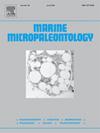海洋门户和环流动力学:揭示中新世以来西赤道太平洋的深层水团特性
IF 1.5
4区 地球科学
Q2 PALEONTOLOGY
引用次数: 0
摘要
中新世时期大西洋和太平洋深水环流的显著变化与构造驱动的海洋通道调整有关,如中美洲海道(CAS)的收缩和关闭。这些构造通道的变化对大西洋经向翻转环流(AMOC)、南极环极洋流(ACC)产生了重大影响,从而导致了南极冰盖的增长,并影响了整个大洋盆地的深水环流路径。通过南极环流关闭大西洋和太平洋之间深水联系的时间以及西太平洋深水环流的相关变化仍有争议。我们研究了赤道西太平洋 ODP 807 号地点有孔虫属 Cibicidoides(Cibicides 的异名)的有孔虫相对丰度及其稳定同位素比值,以破译中新世以来受构造控制的深水环流变化的时间。我们的研究结果与之前公布的数据相关,表明北成分水(NCW)在 12.5 至 9.5 马年之间通过中科院从大西洋侵入西太平洋(807 号站点)。底栖有孔虫 Cibicidoides kullenbergi 在 9.5 Ma ∼突然减少,表明深海水团开始发生重大转变,与大西洋和太平洋之间的主要 δ13C 分异相吻合。本文章由计算机程序翻译,如有差异,请以英文原文为准。
Ocean gateways and circulation dynamics: Unveiling the deep water-mass properties in the western equatorial Pacific since the Middle Miocene
Tectonically driven adjustments in the ocean gateways, such as the constriction and closure of the Central American Seaway (CAS), have been linked to the significant variations in deep water circulations across the Atlantic and Pacific Oceans in the Miocene. The changes in these tectonic gateways had substantial consequences on the Atlantic Meridional Overturning Circulation (AMOC), the Antarctic Circumpolar Current (ACC) and consequently Antarctic ice sheet growth, and deep water circulation pathways across the ocean basins. The timing of the closure of the deep water connection between the Atlantic and Pacific Oceans, through CAS, and related changes in deep water circulation in the western Pacific are still debatable. We examined foraminiferal relative abundances of epibenthic genus Cibicidoides (a synonym of Cibicides) and its stable isotopic ratios to decipher the timing of tectonically controlled changes in deep water circulation since the Middle Miocene at ODP Site 807, western equatorial Pacific. Our findings, correlated with previously published data, suggest the North Component Water (NCW) incursion from the Atlantic to the western Pacific (Site 807) via CAS between ∼12.5 and ∼ 9.5 Ma. An abrupt decrease in benthic foraminifer Cibicidoides kullenbergi at ∼9.5 Ma suggests the initiation of a significant shift in the deep water mass, coinciding with the major δ13C divergence between the Atlantic and Pacific oceans.
求助全文
通过发布文献求助,成功后即可免费获取论文全文。
去求助
来源期刊

Marine Micropaleontology
地学-古生物学
CiteScore
3.70
自引率
15.80%
发文量
62
审稿时长
26.7 weeks
期刊介绍:
Marine Micropaleontology is an international journal publishing original, innovative and significant scientific papers in all fields related to marine microfossils, including ecology and paleoecology, biology and paleobiology, paleoceanography and paleoclimatology, environmental monitoring, taphonomy, evolution and molecular phylogeny. The journal strongly encourages the publication of articles in which marine microfossils and/or their chemical composition are used to solve fundamental geological, environmental and biological problems. However, it does not publish purely stratigraphic or taxonomic papers. In Marine Micropaleontology, a special section is dedicated to short papers on new methods and protocols using marine microfossils. We solicit special issues on hot topics in marine micropaleontology and review articles on timely subjects.
 求助内容:
求助内容: 应助结果提醒方式:
应助结果提醒方式:


